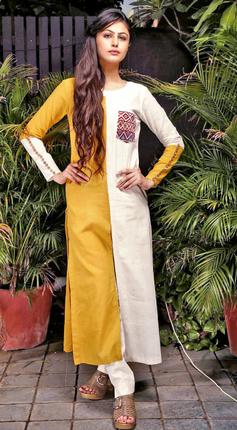

Fashion cannot exist in isolation; it needs to go hand in hand with environmental sustainability. This is design philosophy of Purvi Doshi, who has taken khadi to another level by using it in all her outfits. This entails long hours of manual work, less production sans machine but the designer – a breed apart from her contemporaries – says many positives are working in khadi’s favour.
Explaining the rationale of using the most indigenous fabric, the Ahmedabad-based designer says, “My entire work is in khadi as this is the most natural fabric. Ideal for the Indian weather conditions, it keeps the wearer cool in summers and warm in winters. Organically produced cotton is pesticide-free. It is not easy to obtain as its production, marketing and distribution is slow. As I specialise in khadi, I manage to procure them from Ahmedabad and Bangalore. My target is to use 100 per cent organic cotton in my collection.”
The challenge for Purvi, who launched I Don’t Care, an elaborate solo collection, in the Capital recently, is to make her clothes as skin-friendly as possible. This means giving nylon and polyester a miss. “While pursuing my creativity I have to be responsible to the person who wears my clothes. Nylon and polyester are zeher (poison) for our bodies. As these are petroleum by-products, when the wearer perspires the sweat opens the pores. And this in the long run can lead to skin disease. Moreover in summers, mulmul works the best. We add an extra layering inside so that the khadi does not cause itching.”
Though Purvi goes the traditional way when it comes to using hand spun, handwoven fabric, her designs comprise Indo-Western silhouettes and styles which show how fashion fusion works best. Sari, salwar kameez and anarkali are Indian silhouettes, while skirts, crop tops, waistcoat, long dresses are Western. “Long palazzo compliments khadi because it is a versatile fabric. Gowns have been flared. In sari the ariwork is light but mirror work is heavy. What weighs on the mind is how many sizes should be there but at the same time should not add weight to the sari. Mirror work has been done on the border. Since I am a naturalist I use flowers, birds and trees have been used.”
Colours like hues of blue, green, red and orange are as natural as the fabric. “Plants, leaves and flowers obtained colours have been used in my collection as they enliven clothes.”
To give a modern spin to Indian art, she has used designs which are chic, comfortable and deeply ethnic. “Eccentric cuts give a contemporary look. Asymmetrical cuts add to the beauty of the clothes.”
Outer beauty is important but not at the cost of the wearer. “Harm caused from chemical dyes is immense. Once the pollution emanating from factories producing them starts flowing into our rivers it not only kills our marine life but also harms vegetation.”
That khadi is an employment generator is another prime factor for Purvi. “One machine takes away jobs of 200 artisans, whereas khadi encourages workers to continue work with hands.
Khadi is most suitable for salwar kameez, kurtis and dupatta. It is easier to do embroidery on it rather than imported fabric like crepe. Our research and development is working on a new kind of khadi and we would be using only ahimsa silk as it is obtained without killing the silk worms.”
Justifying the nomenclature of her collection, the designer says, “I do not care if the colours of my dress bleed or fade, I do care that it does not pollute Mother Earth.
If my wonderful tunic does not show the curve of the waist it does not matter as my aim is to highlight our culture. And khadi is our best representative.”
[Source:- The Hindu]





